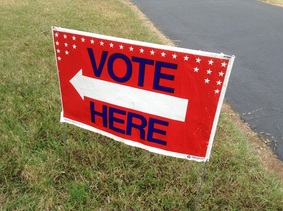 Image © by Brian E. Faulkner
Image © by Brian E. Faulkner But absent the “Nobama” ax the Republicans swung with such gusto, there was a clear lack of strategic underpinning to their midterm messaging. Instead, they allowed the president to make their case for them. He saved the Republicans the trouble of building a brand -- a short-term plus but a long-term minus.
The Democrats had more substance to build on (they always seems to think further down the road than the Republicans), but their 2014 messaging wasn’t all that cohesive, either – at least overtly. However, it was clear to the electorate that the Democrats mostly stood for Obama and his ways, despite some candidates who fled toward the exits in fear of even mentioning the president’s name. Love him or loathe him, the 2014 midterm was a referendum on Mr. Obama, including his carriage, his approach to a frightful list of geopolitical and geo-economic conundrums, his penchant for social reconstruction and his claim to “protect the middle class” – a phrase I would forever ban from all political discourse, not because it isn’t important, not because it isn’t needed or worthy or possible, but because it has been beaten into utter meaninglessness by overuse.
So, as the endless phalanx of political ads finally fades to black, leaving the talking heads to chew things over, this observer has a suggestion for both political parties as they slog toward 2016: come up with a magnetic, meaningful word picture of the years ahead. Recast The American Story in its many manifestations, from Main Street to Wall Street to the Arab Street. Create a message that people can get a grip on, hang their hats on -- or cast aside in favor of the other guy’s take on things.
Democrat or Republican, what’s needed is a hard-working tagline that acts as a stand-in for party "market positioning". Which should include the following characteristics:
1. Simple – uses as few words as possible.
2. Direct – makes a strong, unambiguous declaration.
3. Compelling – connects to both head and heart.
4. Personal – speaks to people’s wants and needs.
5. Strategic – sets your message (or brand) apart.
6. Authentic – grounded in Marketable Truth©.
7. Meaningful – presents tangible benefits.
8. Visual – attracts eye and ear.
9. Memorable – sticks in the mind.
10. Enduring – remains true, even in the face of change.
Readers of this blog know that my subject is communicating competitive advantage. I am no political commentator, but there clearly are parallels between positioning a business, product or brand to advantage and doing so for a political party or candidate. If you spread out the pieces and parts of your belief on a tabletop, you should be able to re-assemble them in a more strategically useful, more refreshing and attractive way, regardless of which political party plucks your heartstrings and moves your feet toward the voting booth.
Use the list of qualities above to guide you in creating a key message, a compact, well-crafted expression of competitive advantage that helps assure consistency in every communication you make – commonly expressed as a tagline. Then lay out a plan to tell your American Story. Start disseminating your message at least by November of 2015. And stick with it. Modify the accents, if needed, but not the core message as party and candidates move together toward November of 2016:
Short, Compelling & Strategic Tagline
- supporting initiative #1
- supporting initiative #2
- supporting initiative #3
- supporting initiative #4
- etc.
Can it be all that simple? Seems so to me. And it just might save us from suffering through two more years of verbal mush, the kind we’ve become all too accustomed to as our national political campaigns unfold.
Content © by Brian E. Faulkner. Marketable Truth © by Brian E. Faulkner

 RSS Feed
RSS Feed